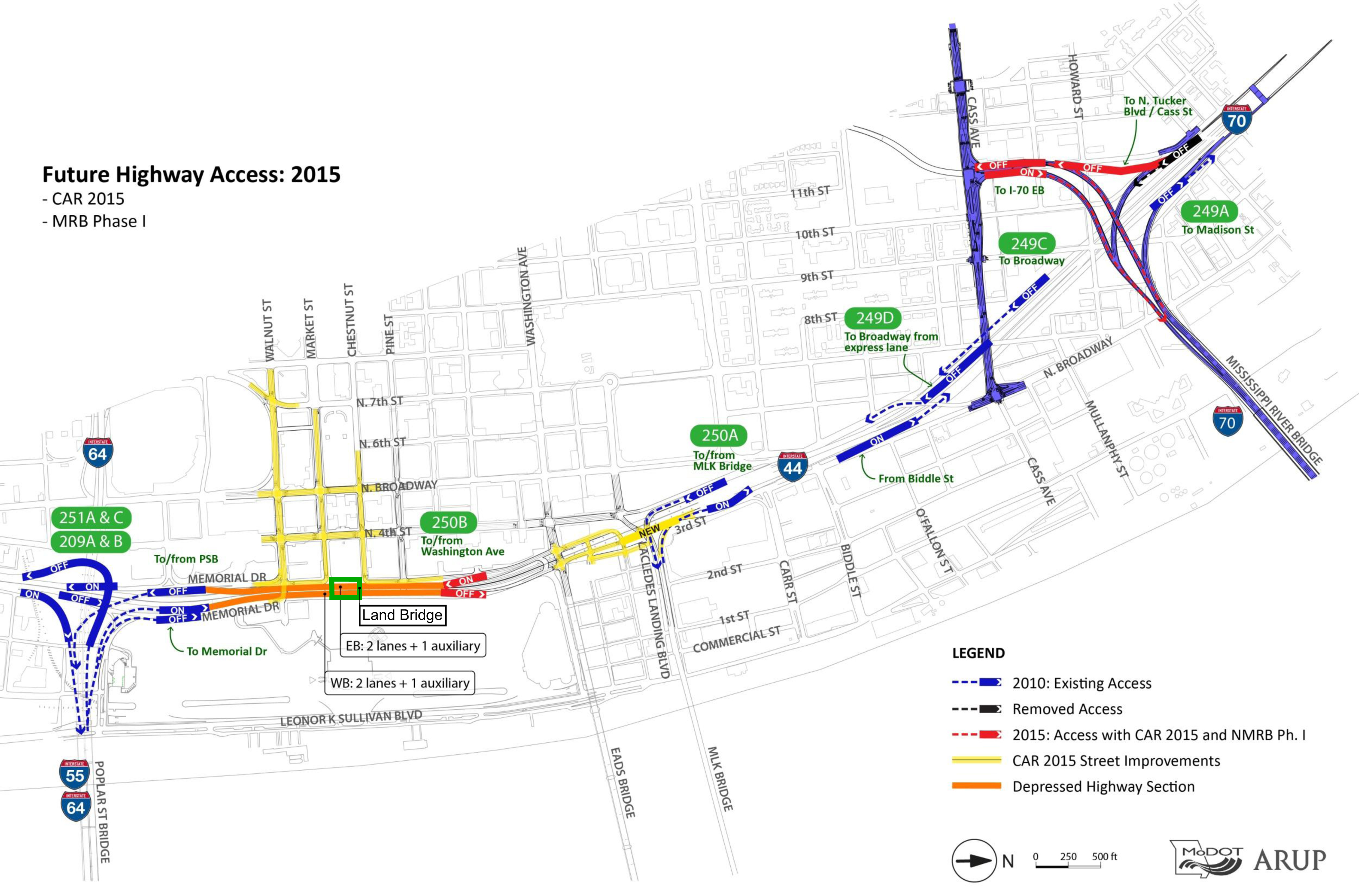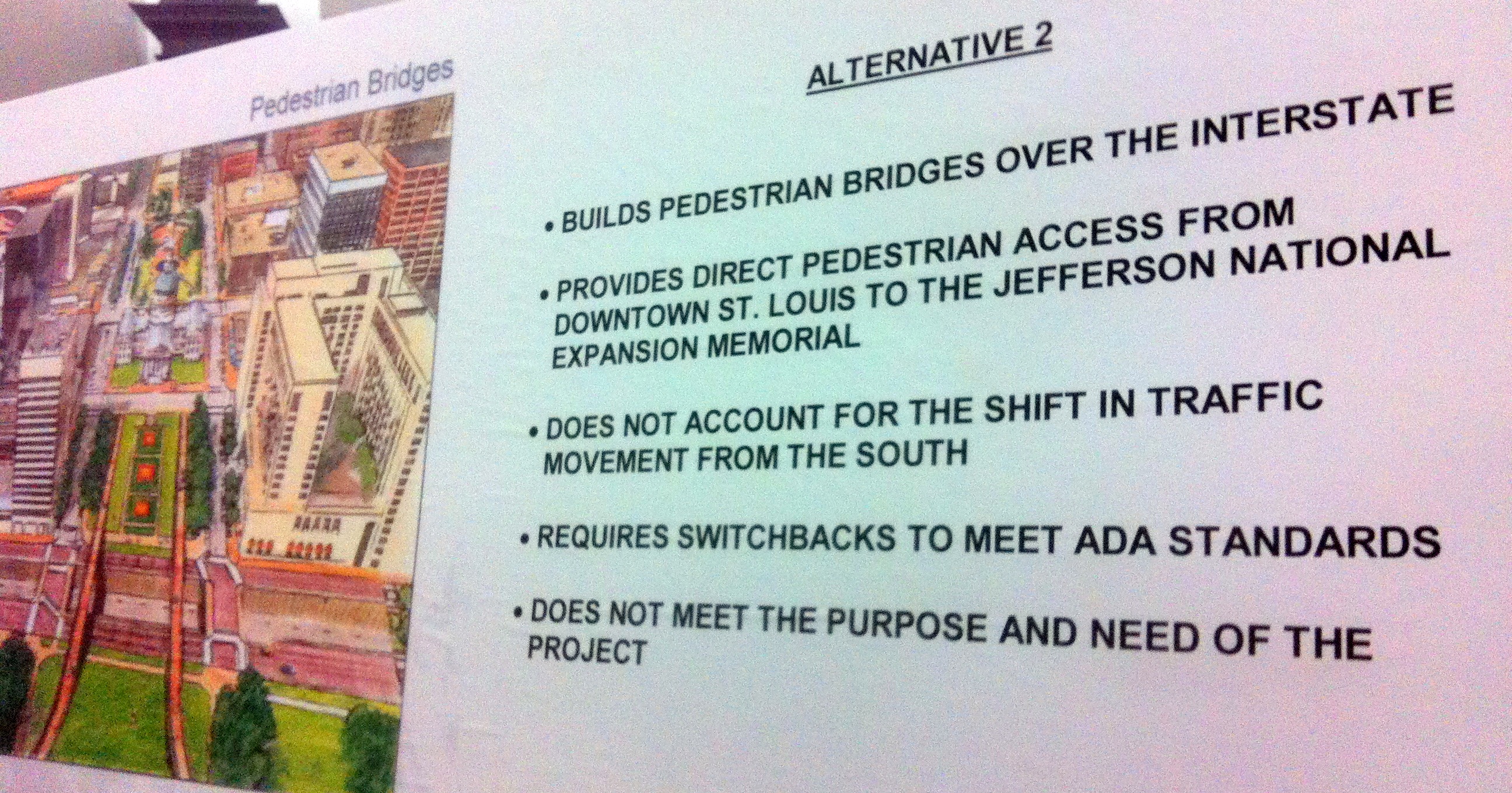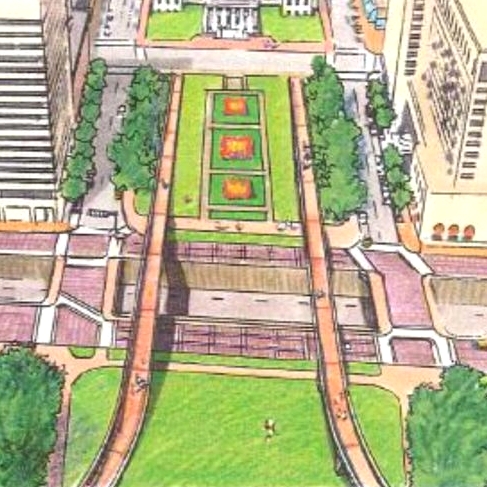 The Missouri Department of Transportation has gone live with their virtual meeting proposing alternatives to the “lid” over I-70 at the Gateway Mall in downtown St. Louis. MoDOT hosted a public open house announced with 12 days notice April 10 from 3:00 p.m. to 5:00 p.m. on the second floor of City Hall. The convoluted and unaccountable nature of the design process continues to be an enormous problem with proposed changes at the Arch. This is highlighted by MoDOT’s stated goals: 1) Support the CAR 2015 objectives while maintaining regional traffic flow, 2) Complete all construction by October 2015 and within budget, 3) Maintain traffic flow levels in and around the downtown area.
The Missouri Department of Transportation has gone live with their virtual meeting proposing alternatives to the “lid” over I-70 at the Gateway Mall in downtown St. Louis. MoDOT hosted a public open house announced with 12 days notice April 10 from 3:00 p.m. to 5:00 p.m. on the second floor of City Hall. The convoluted and unaccountable nature of the design process continues to be an enormous problem with proposed changes at the Arch. This is highlighted by MoDOT’s stated goals: 1) Support the CAR 2015 objectives while maintaining regional traffic flow, 2) Complete all construction by October 2015 and within budget, 3) Maintain traffic flow levels in and around the downtown area.
Unfortunately, MoDOT doubles as a planning agency in our city as not a single political leader has weighed in on a process that could fundamentally change the front door of our city for half a Century, other than to pledge support for an unaccountable and uncommunicative private planning organization. So it’s somewhat surprising that MoDOT is offering two alternatives that would maintain existing connectivity and increase pedestrian access while meeting each of their stated goals. One impressive option suggests finally building an early design element; sweeping pedestrian bridges over Memorial Drive. It is also the least expensive option and best preserves the option of a future urban boulevard. A second option would build a “lid” but perhaps maintain Memorial Drive by routing it under the new greenspace.
There’s no doubt that MoDOT would probably like to bite off the bigger, more transforming, project. It seems highway engineers are like surgeons – trained to intervene and “fix” things rather than opt for the no-build option. They like the build things. The complexity of closing downtown streets and building more infrastructure demands a more comprehensive understanding of the rerouting of I-70 and introduction a new Mississippi River bridge, understanding potential development opportunities and realization of other design impacts on the Jefferson National Expansion Memorial. MoDOT’s Alternative 2 and Alternative 3 are vastly superior to the “preferred alternative”. Each could preserve connections while giving pedestrians a more attractive approach to the Arch.
The irony here is that MoDOT’s alternatives are both labeled “Does not meet the purpose and need of the project.” So perhaps they’re not alternatives. Clearly the ideas have been dusted off the shelf to have something, anything to present the public. One option shows Busch Memorial Stadium in the background and is at least seven years old. The other, likely older. The client for this project is the CityArchRiver2015 Foundation. Clearly they have not asked MoDOT or the project architect to imagine anything other than the “preferred alternative”. Why?
To those viewing the virtual public meeting online and then attending the MoDOT open house, the different descriptions of each alternative were glaring and odd. Online, Alternative 2 states: Gives full pedestrian access to the Jefferson National Expansion Memorial. Project costs are lowest. Does not improve the flow of traffic around downtown, based on existing and projected traffic patterns. Would require switchbacks to meet Americans with Disability Act requirements. At the open house, the bullet points were: Builds pedestrian bridges over the Interstate. Provides Direct Pedestrian Access from downtown St. Louis to the Jefferson National Expansion Memorial. Does not account for the shift in traffic movement from the south, requires switchbacks to meet ADA standards. Does not meet the purpose and need of the project.
Online, Alternative 3 states: Gives full pedestrian access to the Jefferson National Expansion Memorial, Does not improve the flow of traffic around downtown, based on existing and projected traffic patterns. And at the open house: Construct a park over the highway. Memorial Drive west of I-70 would be reconstructed to pass under the new park over the highway between Market and Chestnut Streets and Memorial Drive east of I-70 would be removed between Market and Chestnut Streets. Provides unrestricted pedestrian access from downtown St. Louis to the Jefferson National Expansion Memorial. Does not account for the shift in traffic movement from the south. Does not meet the purpose and need of the project.
On another document, the project “Fact Sheet”, the alternatives are given somewhat different descriptions: Alternative two: Pedestrian bridges crossing over Interstate 44 from Luther Ely Park to the Jefferson National Expansion Memorial. No roadway changes are planned in this alternative. Alternative three: a Park over the Highway structure between Market and Chestnut, with Memorial Drive running underneath the structure. No ramp changes between Interstate 44 and downtown are planned.
Alternative 1:

While MoDOT chose to share a two-mile wide schematic, here is what they didn’t include and what the “preferred alternative” would look like at the Gateway Mall:


{rendering of “preferred alternative” removed the proposed new museum entrance altogether}

{previously released rendering of “preferred alternative” with new museum entrance}
Alternative 2:


Inexplicably, this alternative MoDOT has explored as part of the CityArchRiver design process, which started in 2009, shows Busch Memorial Stadium, which was demolished in 2005. This alternative has not been given any serious attention by MoDOT or project organizers. From this rendering, designers have also apparently been unable (not asked) to imagine anything other than simple sidewalks at Memorial Drive. Despite the lack of serious attention, this remains a vastly superior alternative.

{paths leading to once-planned pedestrian bridges over Memorial Drive can be seen on the Arch grounds}

{the Dan Kiley approved design included sweeping footbridges that were never completed}

{image from 1963 Popular Mechanics article shows Kiley’s footbridges as well}

{existing sidewalk conditions}

{a design alternative – Main Street crossing, 2nd & 3rd streets and I-71 in Cincinnati, OH}
Alternative 3:


This alternative closes Memorial Drive on the east side of I-70, but makes no adjustments to replace access to Washington Avenue, Laclede’s Landing or other destinations. Interestingly, City to River suggested a not-dissimilar design showing a new Memorial Boulevard dipping under a pedestrian lid. MoDOT appears to be showing that this is possible. Why not place both north and southbound Memorial Drive under the lid and preserve connections?

{City to River site plan showing a Memorial Boulevard under a pedestrian lid}
Individuals have the opportunity to tell MoDOT that we should avoid closing city streets and sinking millions more into destructive infrastructure. If you are unable to attend today’s meeting, there is a virtual meeting online where you can view the three alternatives and submit your comments.
Leaving Memorial Drive in place saves millions of dollars. Sunk costs in additional highway infrastructure today will preclude any significant redesign for decades. Specifically, retaining Memorial Drive better preserves the option to convert 1.4 miles of I-70 into an urban boulevard that would stitch together downtown’s most visited attractions (Arch, Busch Stadium, Lumiere Casino and the Landing, the Edward Jones Dome and convention center).
I currently serve as chair of the citizen’s advocacy group City to River, an organization dedicated to enhancing connections between the river and neighborhoods of the central riverfront. We have been articulating the need to study the possibility of highway conversion for several years. In addition to the potential of such a project, we believe that removing city streets as currently planned would decrease connections between the city, the Arch and the riverfront. Many individuals and organizations have expressed support for a more comprehensive and public examination of options for this project that will dictate development patterns in the city for decades.
In addition to massive projects that would reverse and rebuilt highway ramps and more, smaller, more practical, and likely more impactful interventions should be fully explored. The experience of walking from the city to the Arch could be better, needs to be better. Cincinnati’s approach to its city and riverfront offer an excellent example of a path St. Louis should explore, one that does not further disconnect a city by removing streets. Ultimately, the problem with closing Memorial Drive is that it then necessitates 10s of millions of dollars in other changes to build new connectivity where it has been removed.
It’s necessary to revist MoDOT’s stated goals to attempt to evaluate alternatives from their perspective: 1) Support the CAR 2015 objectives while maintaining regional traffic flow, 2) Complete all construction by October 2015 and within budget, 3) Maintain traffic flow levels in and around the downtown area. MoDOT is responding to their client, CityArchRiver, but the city and the Arch grounds aren’t a traffic problem and such concerns should not be allowed to dominate city planning.
MoDOT’s stated deficiencies with Alternative 2 & 3, that “traffic flow isn’t improved”, or that “shifts in traffic movement from the south” isn’t accounted for, do not address the stated goal of “maintaining traffic flow”. In addition, each alternative is less expensive and would be faster to construct than the preferred option. So how is it possible that the two presented alternatives “do not meet the purpose and need of the project”? The only option is that they do not “support the CAR 2015 objectives”, whatever those are. Inadvertently, one must assume, MoDOT has made an excellent case against the “preferred alternative”. The region should listen.


